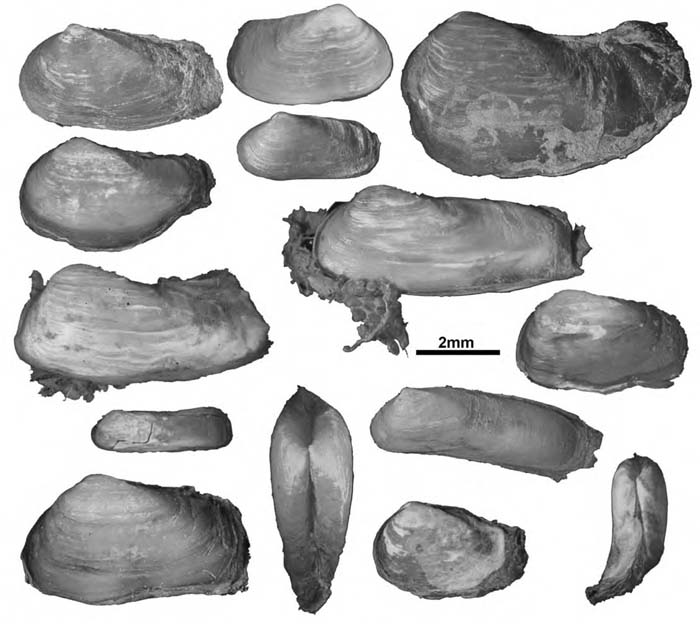 In July 2003 my colleagues in the National Museum of Wales carried out an extensive survey of the benthic communities of the Outer Bristol Channel. Their samples were taken by grabbing and all specimens retained by a 0.5mm sieve were kept. Many of the 70 species of bivalves recorded were small or juveniles, which can be difficult to identify. Amongst some samples, particularly those that included bits of honeycomb worm (Sabellaria alveolata) reef, were many small mis-shapen bivalves. First thoughts led to Hiatella which are very common on the South Wales coast but on closer examination all turned out to be Sphenia binghami. The array of forms found is figured in Plate 1. The bottom row of the plate shows two specimens along with their dorsal views to demonstrate how distorted they can become. The left hand side one is a relatively normal shaped Sphenia, whereas the right hand side specimen twisted. Narrow twisted shells are relatively small and come from inside the empty worm tubes whereas the others are attached to the outer surfaces of the reef. Sphenia’s incredible variation in shape can make it rather difficult recognise and it is likely that this species is underrecorded due to confusion with Hiatella. Externally Sphenia has a weak posterior angle whereas in Hiatella (especially of this size) there are two rows of spines on the posterior slope. Internally the small spoon shaped chondrophore betrays the myoid family position of Sphenia, Hiatella lacks this structure.
In July 2003 my colleagues in the National Museum of Wales carried out an extensive survey of the benthic communities of the Outer Bristol Channel. Their samples were taken by grabbing and all specimens retained by a 0.5mm sieve were kept. Many of the 70 species of bivalves recorded were small or juveniles, which can be difficult to identify. Amongst some samples, particularly those that included bits of honeycomb worm (Sabellaria alveolata) reef, were many small mis-shapen bivalves. First thoughts led to Hiatella which are very common on the South Wales coast but on closer examination all turned out to be Sphenia binghami. The array of forms found is figured in Plate 1. The bottom row of the plate shows two specimens along with their dorsal views to demonstrate how distorted they can become. The left hand side one is a relatively normal shaped Sphenia, whereas the right hand side specimen twisted. Narrow twisted shells are relatively small and come from inside the empty worm tubes whereas the others are attached to the outer surfaces of the reef. Sphenia’s incredible variation in shape can make it rather difficult recognise and it is likely that this species is underrecorded due to confusion with Hiatella. Externally Sphenia has a weak posterior angle whereas in Hiatella (especially of this size) there are two rows of spines on the posterior slope. Internally the small spoon shaped chondrophore betrays the myoid family position of Sphenia, Hiatella lacks this structure.
Sphenia uses a weak byssus to attach itself to a variety of substrates and is a nestling, rather than a burrowing bivalve. It has been recorded from crevices, kelp holdfasts, Hiatella burrows and oyster clumps, in relatively shallow waters up to around 64m, across the NE Atlantic and Atlantic. Sphenia species are found in all oceans and appear remarkably similar wherever they occur, all having the nestling habit.
Mackie A.S.Y., James J.W.C., Rees E.I.S., Darbyshire T. Philpott S.L., Mortimer K., Jenkins G.O. & Morando A. 2006 The Outer Bristol Channel Marine Habitat Study. BIOMÔR Reports 4: 249pp. & Appendix 228pp.
UKBAP http://www.ukbap.org.uk/UKPlans.aspx?ID=32#1 UK Biodiversity Action Plan: Habitat Action Plan for Sabellaria alveolata reefs. Accessed August 2006.
YONGE C.M. 1951 Observations on Sphenia binghami Turton JMBA 30(2): 387-392.
POPPE G.T. & GOTTO Y. 1993 European Seashells. Verlag Christa Hemmen. 221pp.
